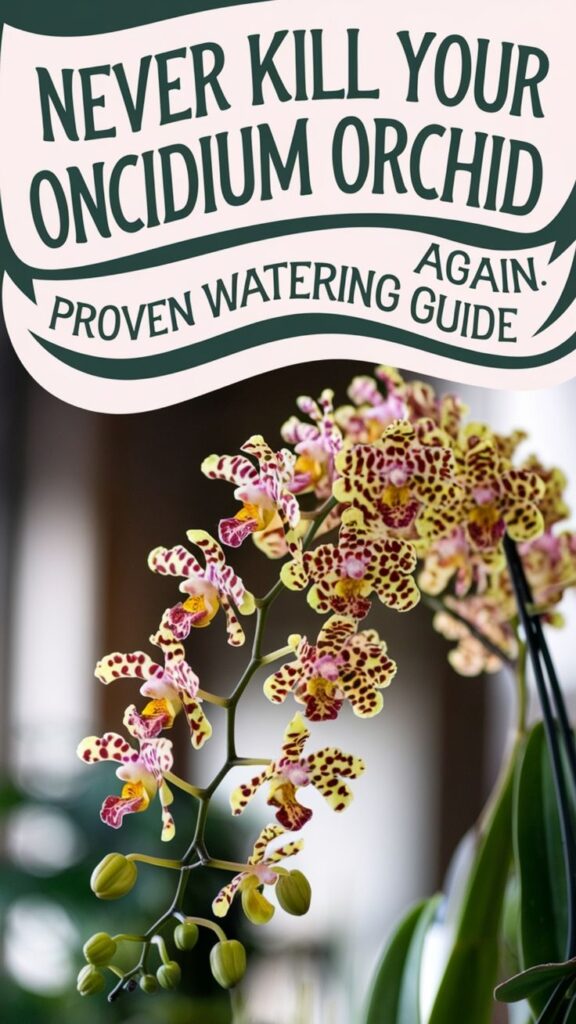Just like a desert cactus won’t thrive in a rainforest, your Oncidium orchid needs its own precise watering balance to flourish. You’ll quickly discover that mastering the art of watering these elegant blooms isn’t as mysterious as it might seem. While many orchid enthusiasts fret over exact schedules, the real secret lies in understanding your plant’s unique signals and environment. Let’s explore how you can crack the code of proper Oncidium hydration.

Contents
Understanding Oncidium Water Requirements
While Oncidium orchids can be forgiving plants, understanding their specific water needs is essential for healthy growth. You’ll want to maintain moderate moisture levels, allowing the top inch of potting medium to dry between waterings. During active growth, these orchids typically need watering every 5-7 days.
Your watering frequency will depend on several factors: humidity levels (ideally 40-60%), temperature (65-80°F), and air circulation. In winter, reduce watering to every 10-14 days as growth slows. You’ll know it’s time to water when the pot feels lighter and the medium appears silvery-gray rather than dark brown.
Signs of Over and Under Watering
Keeping a watchful eye on your Oncidium orchid’s health can help you spot watering issues before they become serious problems. You’ll know you’re overwatering when the pseudobulbs turn soft and mushy, leaves yellow prematurely, and roots appear brown or black with a rotting smell. Signs of underwatering include wrinkled pseudobulbs, leaves that fold inward lengthwise, and aerial roots that look silvery-white and dehydrated.
Overwatering Warning Signs
Three key warning signs indicate you’re overwatering your Oncidium orchid: yellowing leaves, soft black spots near the base, and mushy roots with a foul smell.
When you notice leaves turning yellow, particularly at the base, it’s often the first red flag. Check the pseudobulbs regularly – they shouldn’t feel soft or squishy when gently pressed. If black spots appear, they’ll typically start as small, water-soaked areas before spreading.
The roots tell the clearest story. Healthy Oncidium roots are firm and silvery-green when dry, light green when wet. If they’re brown, mushy, or smell like rotting vegetation, you’ll need to reduce watering immediately and repot in fresh media.
Underwatering Red Flags
Just as overwatering shows distinct symptoms, underwatering presents its own set of warning signs in Oncidium orchids. You’ll notice the pseudobulbs becoming wrinkled and shriveled, while the leaves turn leathery and begin to fold inward along their central veins.
Watch for yellowing that starts at the leaf tips and progresses inward, accompanied by brown, crispy edges. Your orchid’s roots will appear silvery-white and feel brittle to the touch, unlike the plump, green appearance of healthy roots.
If you spot these signs, don’t panic – increase watering frequency gradually, and mist the plant between waterings to boost humidity levels.
Best Water Types and Quality for Oncidiums
Water quality plays an essential role in keeping your Oncidium orchids healthy and thriving. You’ll want to use either rainwater, reverse osmosis water, or distilled water, as these options don’t contain harmful minerals that can build up in your orchid’s roots over time.
If you’re using tap water, let it sit out for 24 hours to allow chlorine to evaporate. The water’s temperature should be room temperature or slightly warmer, around 68-75°F. Don’t use softened water, as it’s typically high in sodium.
For best results, maintain a pH between 5.5 and 6.5. You can test this using standard pH strips from any garden center.
Seasonal Watering Schedule Adjustments
Your properly selected water source needs regular adjustments throughout the year to match your Oncidium’s changing seasonal needs. During spring and summer’s active growth, water every 4-5 days when the potting mix feels slightly dry to the touch. Reduce this to once weekly in fall.
In winter, cut back watering to every 10-14 days, as your orchid enters its natural rest period. You’ll need to water more frequently if you’re running indoor heating or during hot, dry spells. Always check the weight of your pot – a light pot means it’s time to water, while a heavy one indicates sufficient moisture.
Proper Watering Techniques and Methods
Three reliable methods exist for watering Oncidium orchids effectively: thorough drenching, bottom soaking, and misting. For drenching, let tepid water flow through the pot’s drainage holes for 30 seconds, ensuring complete saturation of the growing medium.
Bottom soaking requires placing your pot in a basin filled with 2-3 inches of water for 10-15 minutes, allowing roots to absorb moisture naturally. Don’t forget to drain thoroughly afterward.
Misting works best as a supplementary technique during hot, dry spells. Hold your spray bottle 6-8 inches away, and target both leaves and aerial roots until they’re lightly coated but not dripping.
Container Types and Their Impact on Watering
Since proper container selection dramatically influences an Oncidium orchid’s watering needs, choosing the right pot is essential for your plant’s success. Clay pots provide excellent airflow but dry out quickly, while plastic containers retain moisture longer and work well for moisture-loving varieties.
Your pot should have plenty of drainage holes and measure 1-2 inches larger than the root ball. Clear plastic containers let you monitor root health and moisture levels, but they’ll require more frequent cleaning to prevent algae growth.
Consider using specialized orchid pots with extra ventilation slots along the sides, as they’ll help prevent root rot while maintaining adequate humidity around the roots.
